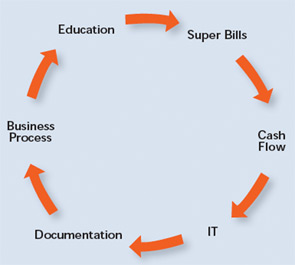
As we move forward in a new era of medicine, it is important to evaluate every aspect of practice management when preparing your practice to sustain the changes coming in 2012.
Managing an efficient practice requires seamless and transparent protocols. Key federal and governmental agencies are targeting risk areas in physician practices to reduce compliance risks and healthcare fraud. While some of the new requirements starting in 2012 initially represent changes with office operations and cost, especially for system upgrades, ultimately the goal is to facilitate quality patient care, proper documentation, provide incentives, and increase productivity.
Changes coming in 2012 include:
- Implementation of Version 5010 and ICD-10;
- Penalties to e-prescribing and electronic health records non-users; and
- Increased audit initiatives.
- Understanding what each change means and the impact it will have on practice management is vital to creating the necessary strategies for success.
Version 5010
Physician practices that electronically submit administrative transactions will have to upgrade their system to Version 5010 by January 1, 2012. The Health Insurance Portability and Accountability standards system upgrade is essential in preparation for the ICD-10 transition. This technical improvement provides the correct length of data fields necessary to submit the increased number of code characters for billing.
This transition will impact primary and secondary claims submission, referrals and prior authorizations, eligibility verification, electronic remittance, payments, and plan enrollment, specifically:
- Appointments and scheduling—transaction format changes;
- Eligibility—confirmation of coverage transaction files;
- Claims billing—transaction files for electronic billing;
- Payment processing—receiving remittances;
- Follow-up—claim status and remittance status; and
- Interfaces—transactions sent between integrated systems.
The implications of not being ready for the implementation of Version 5010 are clear: you will not be able to submit electronic transactions in any format. Failure to successfully transition to the new formats by January 1, 2012, will jeopardize claim processing and reimbursement. More importantly, Version 5010 is the platform to report the new diagnosis code set ICD-10.
With three months left, there is still time for practices to perform a readiness assessment in the office and with trading partners (e.g., billing services or clearinghouses). View the CMS transition checklist at www.cms.gov/Versions5010andD0/Downloads/w5010PvdrActionChklst.pdf.
International Classification of Disease, Tenth Revision
Implementing the ICD-10 code set is an important step in reporting diagnosis codes to improve quality health data management and patient care. CMS has set October 1, 2013, as the compliance date for the coding crossover. Although that seems like light years away, you should begin the implementation process in 2012 for a successful transition the following year.


